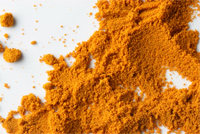Turmeric—Medicinal & Delicious
By Dr. Robert Luby, Co-op Member
 Note: While this article discusses the medicinal properties of turmeric, it is not meant as a substitute for proper medical advice. Please consult with your medical practitioner before using any type of remedy, herbal or otherwise.
Note: While this article discusses the medicinal properties of turmeric, it is not meant as a substitute for proper medical advice. Please consult with your medical practitioner before using any type of remedy, herbal or otherwise.
The spice turmeric (sometimes spelled “tumeric”) comes from the herb known as Curcuma longa, which is in the ginger family. It is the rhizome, or the underground portion of the plant, which is used in making the spice. The rhizomes look very similar to ginger root, but with a deeper orange-gold color. It is this color which imparts the familiar color to curried dishes.
Medical interest in turmeric has peaked in the last decade due to its potential in treating many of the acute and chronic inflammatory conditions which are becoming more prevalent with the standard Western diet and lifestyle. It is now well-established that turmeric possesses anti-inflammatory, antioxidant, antiviral, antifungal, antibacterial, and anticancer properties in animal studies.1,2,3 Preliminary human studies show promise for turmeric in the treatment of conditions such as osteoarthritis, Alzheimer’s disease, ulcerative colitis, irritable bowel syndrome, peptic ulcer, pancreas cancer, and eczema.4-10
The specific targets of the medicinal components of turmeric appear to be many of the same mediators as are targeted by more expensive and toxic pharmaceutical drugs. These targets include NFkappaB, cyclooxygenase-2 (COX-2), lipooxygenase (LOX), inducible nitric oxide synthase (iNOS), and leukotrienes, to name a few. But unlike these pharmaceutical products, turmeric has been shown to be very safe, producing no toxicity at doses up to eight grams per day.1,2,3
Turmeric is especially important at assisting the detoxification efforts of the body and protecting the liver. Combined with cruciferous vegetables, which are also beneficial detoxification aides, it is both medicinal and delicious. In addition to its benefits when ingested, it also has potent antiseptic qualities when applied topically to the skin. It has been used for centuries as an aid to wound healing.
Unfortunately, turmeric is not an herb that grows well in our local climate. More than 90% of turmeric is grown in India. The annual harvest occurs from January into April, so this is the best time to consume the fresh rhizome. When shopping for fresh turmeric, look for firm, uniformly colored “fingers” or rhizomes. Avoid discolored, soft, and moldy-appearing pieces.
Preparation of the fresh rhizome usually involves peeling the skin prior to grating or slicing. It may also be frozen whole for use later in the year. When removed from the freezer, it is best to grate it immediately. Turmeric is also available as a powdered spice. For a particularly medicinal “spice cocktail” combine equal parts powdered turmeric and ginger with a pinch of cayenne. Sprinkle this over any and all cruciferous vegetables drizzled with organic coconut oil. This combination, in addition to assisting digestion and detoxification, is simply delicious. Turmeric is also particularly well suited for soups and stir fries, marinades (especially lamb), and of course curries.
My favorite turmeric recipe of all will surprise you: Turmeric Ice Cream. Combine two cups of organic cream, one can (13.5 oz.) of organic coconut milk, two teaspoons of vanilla, ¾ to 1 cup organic raw sugar (or ½ to 1 teaspoon powdered stevia). Add four to eight “fingers” of grated fresh turmeric and watch your ice cream maker produce the most beautiful, delicious, and healthy ice cream you have ever tasted.
No matter how you decide to use it, turmeric will add flavor, color, and nutrition to your meals. City Market carries turmeric at all times of the year in its dry, powdered form in the bottled spice section and the Bulk Department of the store. Look for fresh turmeric rhizomes in the Produce Department in the late fall and early winter.
References:
- Trends Pharmacol Sci. 2009 Feb;30(2):85-94
- Adv Exp Med Biol. 2007;595:1-75
- Adv Exp Med Biol. 2007;595:105-25
- J Altern Complement Med. 2009 Aug;15(8):891-7. (OA)
- J Alzheimers Dis. 2009 Jul;17(3):703-17
- BMC Neurosci. 2008 Dec 3;9 Suppl 2:S13 (AD)
- Acta Med Indones. 2008 Oct;40(4):201-10 (eczema)
- Clin Cancer Res. 2008 Jul 15;14(14):4491-9 (pancreatic cancer)
- J Altern Complement Med. 2004 Dec;10(6):1015-8 (IBS)
- Southeast Asian J Trop Med Public Health. 2001 Mar;32(1):208-15 (peptic ulcer)